Do you want to build beautiful landing pages for your WordPress website? With the right page builder, you can transform simple website pages into high-converting landing pages that grow your email list and increase your business revenue.
But which page builder is the best?
In this article, we’ll compare Elementor vs Divi vs SeedProd to see which landing page builder comes out on top.
First, let’s explore what a page builder is and which features you should look out for.
What Is a WordPress Page Builder?
A WordPress page builder is a WordPress plugin that makes it easy to build professional looking landing pages without hiring a developer. You can use page builders to create almost any type of landing page, including sales pages, thank you pages, webinar registration pages, and more.
The majority of page builders have drag and drop functionality, so you can build your page visually using content blocks and modules.
While some page builders let you construct pages from your WordPress website’s admin, the very best solutions allow you to do so visually. This means you can instantly see the changes you make in real-time as you make them.
The most popular WordPress landing page builders come with various page elements for building out your pages, such as:
- Contact forms
- Social media profile buttons
- Countdown timers
- Call to action buttons
- Email optin forms
- Testimonial widgets
- Start ratings
- And much more.
You can also usually choose from several pre-made landing page templates and themes to give you a head start in the design process. Almost all page builder plugins integrate with popular email marketing services to grow and manage your email list.
What to Look for In a WordPress Page Builder
When choosing a WordPress page builder, here are a few things you should look out for:
- Ease of Use: A page builder should make the process of building pages easy. Drag and drop functionality is a must-have feature to look for as it allows you to move page elements around with your mouse.
- Pre-made templates: Templates provide the basic design and structure of pages, so you won’t need to start from scratch. Look for a page builder with a range of different templates designed for specific types of landing pages.
- Responsive design: Your landing pages should be mobile friendly and adapt to different mobile devices. Look for a page builder plugin with responsive options and the ability to preview and edit pages in various screen sizes.
- Customization: You’ll want a page builder with plenty of options to customize your pages to suit your business needs. You should be able to change colors, fonts, backgrounds, and more, so the page represents your brand.
- Speed: Your website’s speed is important for your click-through rates and how you rank in search engines like Google. Choose a page builder that’s bloat-free and optimized for speed.
- Affordability: You won’t want to spend a ton of money building your landing pages, but it’s important you choose an option that has all the features you need. Look for a page builder that offers essential features at a reasonable price point.
Now that you know what a page builder is and which features to keep an eye out for let’s compare 3 of the most popular page builders on the market.
Summary: Elementor vs Divi vs SeedProd
Before we dive into a more detailed comparison of the top WordPress page builders, here’s a summary of our findings for SeedProd, the Divi Builder, and Elementor.
| Page Builder | Description | Price |
|---|---|---|
| 1. SeedProd | Best WordPress Landing Page Builder | $39.50/y |
| 2. Elementor | Top WordPress Website Builder | $49/y |
| 3. Divi | Best WordPress Theme Builder | $89/y |
Features: Elementor vs Divi vs SeedProd
To begin this comparison, let’s look at the different features available in the 3 top page builders for WordPress; Elementor, Divi, and SeedProd.
Elementor Features

Elementor is a popular WordPress website builder with all the features you need to build professional-looking websites without hiring a developer. It’s designed as an all-in-one web design solution to control every aspect of your website, all in one place.
The free version of Elementor is a good choice if all you want is to make simple page edits. Whereas Elementor Pro grants access to the following features:
- Full website design kits
- 300+ premade templates
- 50+ widgets and page modules
- Drag and drop page editor
- Design customization
- Visual editor
- Inline editing
- Theme builder
- Form builder
- WooCommerce builder
- Popup builder
- Responsive editing
- Popular marketing integrations
As you can see, Elementor is designed to be a complete website solution all in one powerful package.
Divi Features
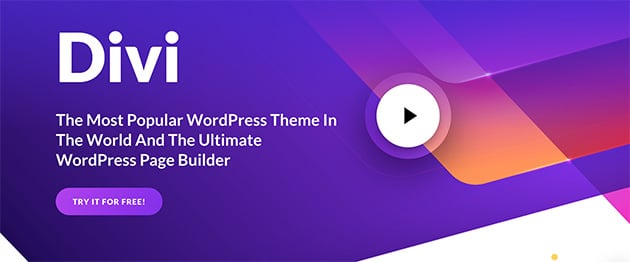
In comparison to Elementor, Divi is both a WordPress theme and a page builder created by the Elegant Themes team. While the page builder comes bundled with the Divi theme, it can still be used as a standalone builder.
Divi doesn’t currently offer a free version of the plugin; however, you can try a demo on the website to see how it works.
With Divi, you can access these premium features:
- Drag and drop page builder
- Visual page editor
- Divi WordPress theme
- Modules and page elements
- Design customization tools
- 100+ website layout packs
- Inline editing
- Responsive editing
- Email marketing integration
- Contact form building
- Built-in split testing
- WooCommerce integrations
- Theme building
Similar to Elementor, Divi is a complete website solution for business owners who wish to control every aspect of their website design.
SeedProd Features
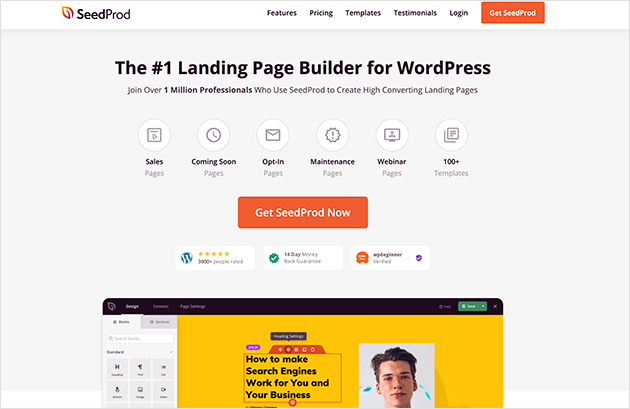
SeedProd is the only option in this comparison post devoted to building high-converting landing pages in WordPress. It focuses squarely on providing all the essential features you need to create beautiful pages quickly and easily that get the results you need.
SeedProd has a free version that lets you build specific landing pages, such as:
- Thank you pages
- Sales pages
- Webinar registration pages
- Squeeze pages
- 404 Error pages
- And more
The free version also offers a wide variety of landing page templates to help you get started quickly. And you can use the visual drag and drop builder to customize your page in real-time, complete with inline editing.

SeedProd’s standard page blocks are included in the free version, including headline, text, image, button, video, divider, spacer, and column blocks.
You can also access the advanced giveaway and contact form blocks for free so that users can get in touch, and you can run a viral giveaway right on your landing page.
Best of all, you can put your website in maintenance mode or enable a coming soon page with SeedProd at zero cost.

The paid version of SeedProd has everything from the free version and the following features:
- Pre-made page layout sections including Hero, FAQ, CTA, Header, Footer, and Features sections.
- Premium email integrations, including Drip, Constant Contact, GetResponse, and more.
- Spam protection with Recaptcha.
- Powerful Access Controls to limit who can see your page while under construction.
- Landing page-specific content blocks, including optin forms, countdown timers, star ratings, social profiles, social sharing, progress bars, and much more.
- Domain mapping so you can point landing pages to different domain names other than your main website.
Instead of having all the features you can imagine, SeedProd puts its focus on ensuring you have everything you need to create high-converting landing pages easily in WordPress.
Ease of Use: Elementor vs Divi vs SeedProd
Now that we’ve explored each page builder plugin’s features, it’s time to take a look at how easy they are to use.
For this comparison, we’re using the Pro versions of all 3 plugins and the Twenty Twenty WordPress theme.
Elementor Ease of Use
Creating a new page in WordPress with Elementor is relatively straightforward. The different page elements are arranged on the left-hand side of your screen while a page preview is visible on the right. Moving elements around on the page is as simple as pointing, clicking, and dragging.

Clicking the folder icon in the page editor reveals the template library where you can choose a pre-made design and add it to your page.

After picking a template, it might not look right at first. To solve that, you’ll need to change your page attributes in the standard WordPress editor to use the Elementor Full-Width template. After that, it should show in the editor, just like the template preview.
There’s a massive list of different page modules included in Elementor, which are divided into categories. This can be overwhelming at first glance; however, you can expand or hide different categories to make the module panel less cluttered.

Clicking any element on your page opens several options in the left-hand panel. This is where you can choose different style options, content, motion effects, and more.
It isn’t immediately clear how you can connect Elementor to your email marketing service of choice. It’s only after adding a form to your page, that you can choose an integration from a drop-down menu.
Overall, Elementor is easy to use and has more than enough design settings to create beautifully customized websites.
Divi Ease of Use
When creating a new page with Divi, you’re instantly asked if you’d like to start from scratch or choose a pre-made layout. The layouts come in packs with several themed templates made for different types of pages. This is an excellent choice if you want to create a complete website design.

The visual page builder doesn’t have a left-hand sidebar like Elementor. Instead, a small popup appears where you can search for and add new page elements.
Once the element is added to your page, another small window appears where you can make your customizations.

The window can be resized and moved anywhere on the page. Inside that window are different tabs devoted to changing the content, design, and advanced settings, such as custom CSS and animations.
Integrating your email list with Divi is a little easier than Elementor. After adding an optin form to your page, you can choose a provider under the Email Account heading.
We found Divi’s approach to customizing landing pages confusing for beginners. The customization panel was often in the way of the page design, making it difficult to navigate.
SeedProd Ease of Use
Creating a high-converting landing page with SeedProd is super easy. First, download SeedProd, then follow this step-by-step guide to install a WordPress plugin.
Upon installing and activating the plugin, click the SeedProd icon in your WordPress admin area to view the SeedProd landing page dashboard.
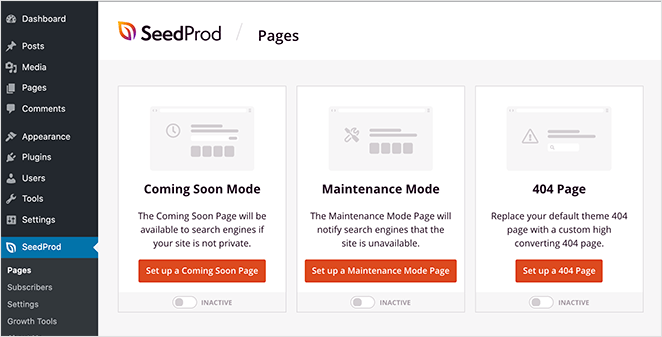
You can create and activate a coming soon page, maintenance mode page, and a 404 page on this page and turn each mode on and off with a single click.
Beneath that section, you can click the Add New Landing Page Button to build your first page.
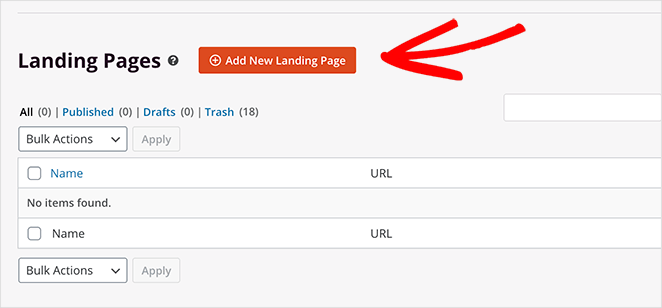
Immediately after clicking the button, you’ll see the SeedProd landing page template library. The different templates are categorized by page type, like sales, webinar, lead squeeze, thank you, etc.

Once you’ve found a template you like, just hover your mouse over the thumbnail and click the tick icon. You can then give your page a name and URL and launch it in the drag and drop page builder.
SeedProd’s visual page builder is the most straightforward in this comparison. The design panel is on the left-hand side of the screen with a live page preview on the right.

Instead of having a massive variety of options to choose from, SeedProd’s landing page blocks are divided between Standard and Advanced blocks.
The Standard section is devoted to the most widely used page elements, such as image blocks, text, videos, buttons, etc.
In contrast, the Advanced section is where you’ll find the landing page focused blocks.
These blocks are specifically designed to help your lead generation efforts and include:
- Giveaway Block: Connect your landing page to a RafflePress giveaway and use viral online contests to promote your page.
- Contact Form: Integrate with WPForms, the best contact form plugin, and show powerful WordPress forms on your landing page.
- Optin Form Block: Show a customizable optin form and connect it to your favorite email marketing service to grow your list.
- Countdown Timer: Create a sense of urgency and show users how long is left until your offer runs out.
- Star Rating: Increase trust with your target audience by showing how other users rate your products or services.
Clicking any of the content blocks on your page shows the different customization options. These are organized by Content, Template, and Advanced.
The Content tab allows you to control the information included in each page element, while the Template tab has several pre-made styles you can use with a single click.

In the Advanced tab, you can change the appearance of borders, individual colors, spacing, and more.
For all the steps on creating a high converting landing page with SeedProd, check this guide out.
Integrating your SeedProd landing page to an email marketing service is as simple as clicking the Connect tab and choosing an option from the list.

Once the provider is linked to SeedProd, anyone who uses your page’s sign up form is automatically added to your list.
Page Speed: Elementor vs Divi vs SeedProd
The speed of your landing page plays a crucial role in its performance, both in terms of how many leads and sales you get and how well it ranks in search engines. Even a small delay in loading times can impact your search results and click through rates.
With that in mind, we decided to test each page builder plugin to see how they fared.
For this test, we created a simple landing page with a headline, image, and button.
Here are the results:
| Plugin | Load Time | Requests | Page Size |
|---|---|---|---|
| Elementor | 1.14 s | 32 | 535.4 kb |
| Divi | 891 ms | 18 | 407.2 kb |
| SeedProd | 770 ms | 17 | 359.1 kb |
As you can see, the plugin with the most significant load time was Elementor, while SeedProd has the quickest load time, least requests, and the smallest page size overall.
However, when we ran the same test in Isolation Mode in SeedProd, which only loads what is needed to render the page, the page size shrank to 96.6 kb, with only 7 requests and a load time of 702 ms.
Support: Elementor vs Divi vs SeedProd
Now that we’ve taken a good look at each page builder, it’s time to see what support is available. Accessing quality help and advice can help you get up and running quickly and ensure you get the best results for your business.
Elementor Support

Elementor has a variety of options available for users who need help and support. The help center has documentation on every aspect of their plugin, frequently asked questions, and video tutorials that walk you through using Elementor.
You can submit a support ticket for extra help, whereas Pro users can access premium support 24/7.
Elementor also has both a Facebook and GitHub community where you can get your questions answered.
Divi Support

In comparison, the Divi builder has detailed documentation with step-by-step videos and a support forum where you can post your questions about the plugin. Divi also has a live chat option that allows users to chat with a support team member with any queries.
If you’d like to speak to the Divi community, you can access the Divi Theme Users Facebook group.
SeedProd Support

Users of SeedProd’s page builder plugin can enjoy round the clock support from a team of WordPress experts via the ticketing system. There is also plenty of documentation detailing all of SeedProd’s features, with step-by-step video tutorials to guide you through the design process.
The SeedProd blog is also packed with helpful guides and tutorials. This will help you get the most from the plugin.
Since SeedProd is part of the Awesome Motive family of WordPress products, users can also access the WPBeginner Facebook Group, which boasts over 64,000 members for help and support.
Pricing: Elementor vs Divi vs SeedProd
With all the essentials covered, let’s look at all 3 plugins’ price points to see which option offers the best value.
Elementor Pricing
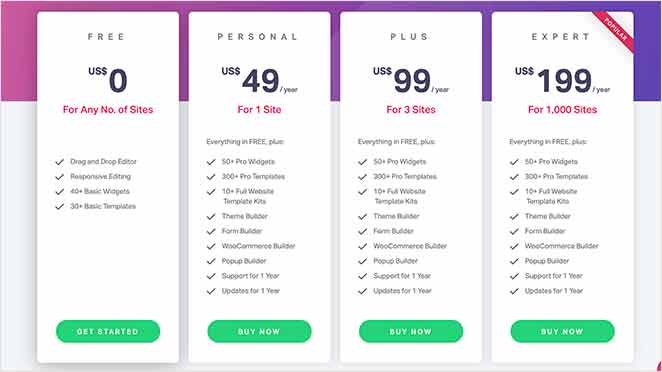
As mentioned earlier, Elementor has a free version that you can try before upgrading.
After that, the pricing starts at $49 per year for 1 website. The pricing then scales up depending on how many sites you wish to use it on.
Divi Pricing

Divi comes as part of a bundle of other Elegant Themes products, with pricing starting at $89 for yearly access. Alternatively, you can pay a one-time fee of $249 for lifetime access.
SeedProd Pricing
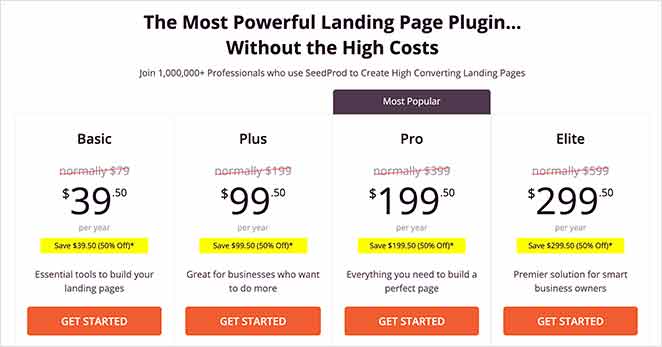
Like Elementor, SeedProd offers a free version that includes all the landing page templates you’d need to get started.
Upgrading starts at just $39.50 per year for 1 website. They also offer a 100% no-risk money-back guarantee valid for 14 days after your purchase.
Which Is the Best WordPress Page Builder?
Now that we’ve compared the Elementor vs Divi vs SeedProd, which page builder is the best?
Our top pick for the best WordPress page builder is SeedProd.
SeedProd is the only plugin in this comparison dedicated to perfecting the art of creating high-converting landing pages. It’s easy to use and doesn’t include any unnecessary features that can confuse the design process.
SeedProd integrates with the most popular email marketing services, and because the plugin is entirely bloat-free, it won’t slow down your website.
So what are you waiting for?
And if you liked this article, then please follow us on Twitter and Facebook for more useful content to help grow your business.
The post Elementor vs Divi vs Seedprod: Which Page Builder Wins? appeared first on SeedProd.